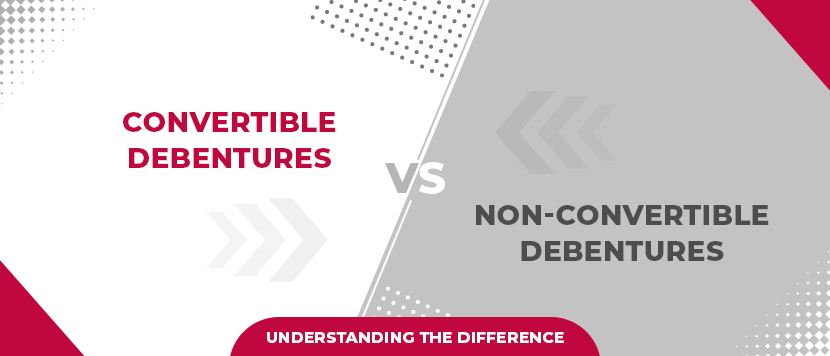History of Union Budgets in India: From 1947 Crisis to Viksit Bharat – Key Milestones
Difference Between Convertible and Non-Convertible Debentures

Last Updated: 9th December 2022 - 10:43 am
Debentures, along with bonds, are one of the most popular debt instruments. Usually, when companies, and sometimes even the government, wishes to raise funds from the public, they issue debentures.
There are different types of debentures, which are categorised based on redeemability, transferability and convertibility. Based on the convertibility, debentures are further classified into two types – convertible debentures and non-convertible debentures.
Another lesser-known debenture type is the partially convertible debenture. In this case, the company that issues the debenture dictates the percentage of the debenture that may or may not be converted into company stocks.
Let us look at the difference between convertible and non-convertible debentures. The comparison can be drawn on different parameters, which are discussed below.
Definition
Convertible debentures are a type of debentures that can be converted into equity shares of the company.
Non-convertible debentures are defined as the type of debentures that cannot be converted into equity shares of the company.
Rate of Interest
The convertible debentures have a lower interest rate than non-convertible debentures since the holders have the advantage of converting them into equity shares.
The non-convertible debentures have a higher interest rate. However, these debentures are considered a little risky than convertible debentures and bonds.
Maturity value
The maturity value of convertible debentures mainly depends on the company's stock price at the time of issuing the debenture. If the stock price is high, it will give higher returns, and low stock prices mean it will provide low returns. A vanilla convertible bond provides the investor with the choice to hold the bond until maturity or convert it to stock. If the stock price has decreased since the bond's issue date, the investor can hold the bond until maturity and get paid the face value.
On the other hand, the maturity value of the non-convertible debentures remains fixed, and they give fixed returns on maturity.
Status
This is one of the significant distinguishing factors between convertible and non-convertible debentures.
If you hold convertible debentures, you can enjoy either the status of being a creditor to the company or the owner of the company.
Whereas, if you hold non-convertible debentures, your status will be the creditor of the company.
Final Word
Now that you are aware of the difference between convertible and non-convertible debentures, carefully assess your investment goals before making the final decision. Generally, experts suggest that it is best to put 5 to 10% of investment savings in the convertible debentures and invest the rest in the traditional bonds and other investment options.
You can consider investing in IIFL Home Loan Bonds. It is issued by IIFL Home Finance Limited, the non-banking finance arm of the IIFL Group. It has a long-term AA+/Negative credit rating by Brickwork and an AA/Stable rating by CRISIL. Click here to know more about IIFL Home Loan Bonds.
DISCLAIMER: IIFL Home Finance Limited (Formerly known as India Infoline Housing Finance Limited), subject to market conditions and other considerations is proposing a public issue of secured and/or unsecured, redeemable non-convertible debentures and has filed the Shelf Prospectus and Tranche I Prospectus both dated June 29, 2021 with the Registrar of Companies, Maharashtra at Mumbai, National Stock Exchange of India Limited, BSE Limited and SEBI. The Shelf Prospectus and Tranche I Prospectus both dated June, 2021 are available on our website www.iifl.com/home-loans, on the website of the stock exchanges at www.nseindia.com and www.bseindia.com, on the website of SEBI at www.sebi.gov.in and the respective websites of the lead managers at www.edelweissfin.com, www.iiflcap.com, www.icicisecurities.com, www.trust group.in and www.equirus.com. Investors proposing to participate in the Issue, should invest only on the basis of the information contained in the Shelf Prospectus and Tranche I Prospectus both dated June 29, 2021. The unsecured, redeemable, non-convertible debentures will be in the nature of subordinated debt and shall be eligible for Tier II capital. Investors should note that investment in NCDs involves a high degree of risks and for details relating to the same, please refer to Shelf Prospectus dated June 29, 2021, including the section on “Risk Factors” beginning on page 19 of the Shelf Prospectus dated June 29, 2021.
Source: This content is created and hosted originally on www.indiainfoline.com and provided here for our customers' information.
- Flat ₹20 Brokerage
- Next-gen Trading
- Advanced Charting
- Actionable Ideas
Trending on 5paisa
01
 5paisa Capital Ltd
5paisa Capital Ltd
Indian Stock Market Related Articles
Disclaimer: Investment in securities market are subject to market risks, read all the related documents carefully before investing. For detailed disclaimer please Click here.




